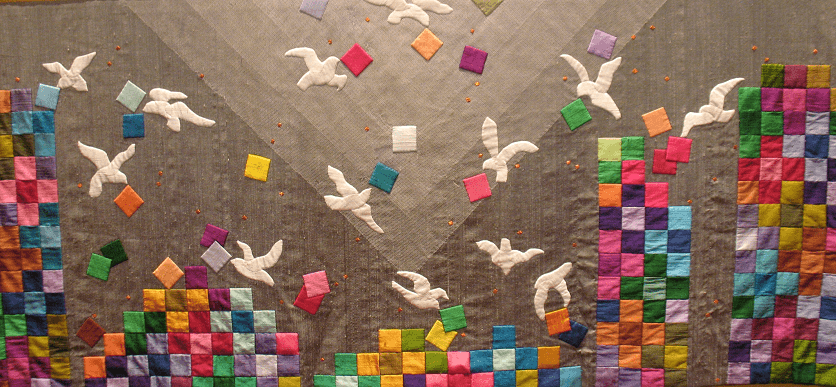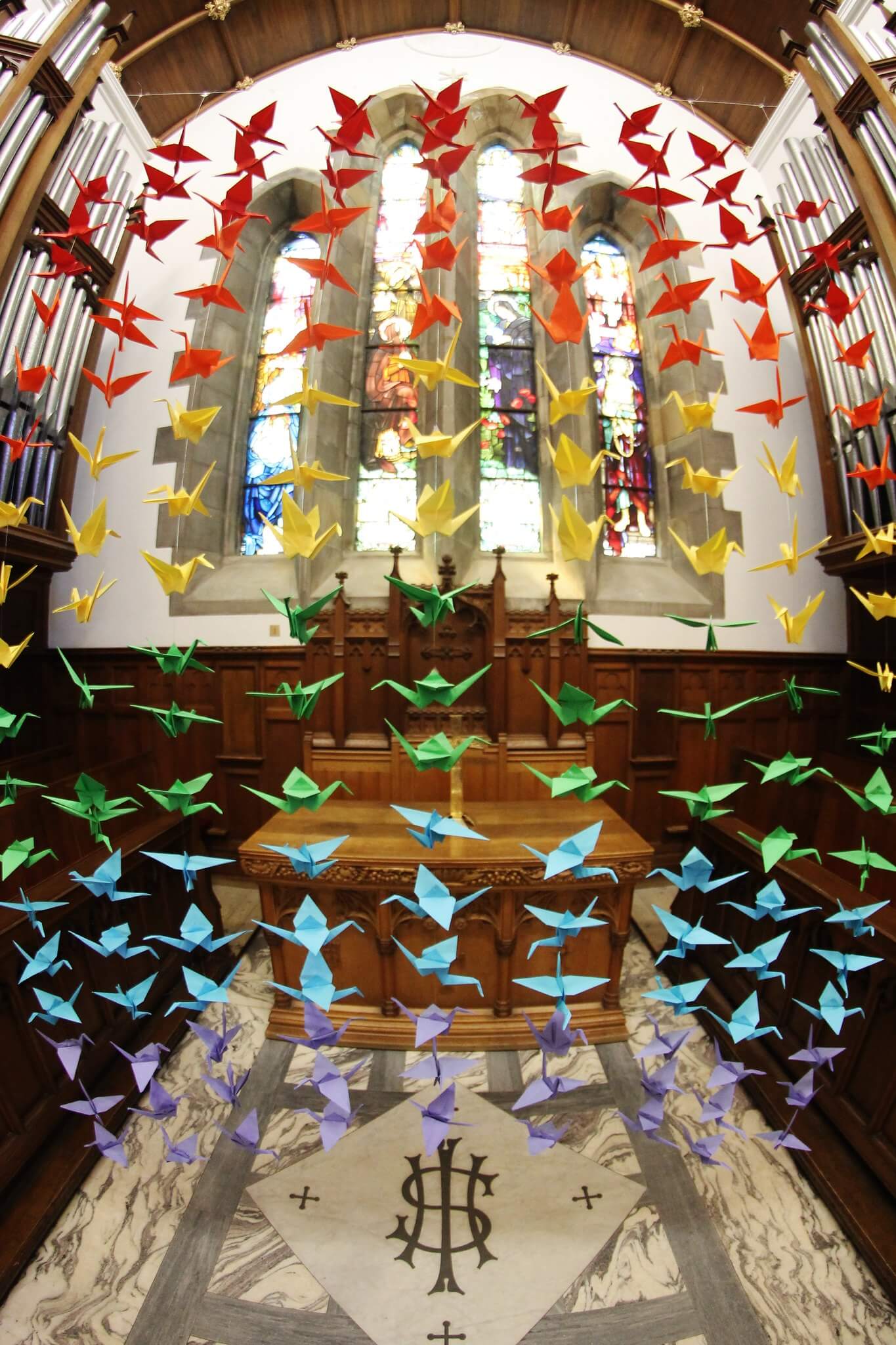Wisdom 3:1-9 Psalm 24 Revelation 21:1-6a John 11:32-44
A Cloud of Witnesses
Sherman Hesselgrave
All Saints is when the universal Church remembers the Christian faithful throughout history who make up the great cloud of witnesses, the communion of saints who surround us and inhabit our memory across time. If I asked you to think of a person you consider to be a saint—someone who has inspired you by their courage or their convictions, someone you aspire to be like, someone who left their fingerprints on your life, I’m sure you could name them or see them with your mind’s eye. Even though they were touched by death, they live on in our hearts and in our memories.
A week ago our world was shattered by the news that a gunman, shouting hate, entered the Tree of Life synagogue in Pittsburgh and took the lives of eleven people worshipping there. Once again, a sacred space had been violated by bullets—like a mosque in Quebec and a black church in Charleston, South Carolina. People of faith, who lived and loved, who gathered to worship a God of peace and hope, were cruelly and abruptly silenced.
One of my seminary classmates posted a poem on her Facebook page by the Medieval Spanish Jewish physician and poet, Judah Halevi (c.1075-1141) following the news from Pittsburgh:
‘Tis a Fearful Thing
‘Tis a fearful thing
to love what death can touch.
A fearful thing to love, to hope, to dream,
to be.
And oh, to lose.
A thing for fools, this.
And a holy thing,
a holy thing to love.
For your life has lived in me,
your laugh has lifted me,
your word was gift to me.
To remember this brings painful joy.
‘Tis a human thing, love,
a holy thing to love.
I think it IS love that is the glue that unifies the great cloud of witnesses that surrounds us. Jesus said, “This is my commandment: that you love one another as I have loved you.” Selfless love—agapé. And living out that commandment gets incarnated in many different ways. A few years ago, when a group of Canadians was attacking mosques, insisting Muslims had no place in Canada, many of us surrounded our neighboring masjid to demonstrate our disagreement with that belief and to affirm our solidarity with the right of all people to worship in their own way in peace and safety. Yesterday, there was a gathering of people of different faiths who circled the City Shul and other synagogues in Toronto during Shabbat services to show solidarity in the aftermath of the assault on the synagogue in Pittsburgh last week. Some folks from Holy Trinity were there. A friend from out of town, who has been staying with me during the Parliament of World Religions, was also there yesterday morning, and as we were debriefing our respective days last night, we asked the rhetorical questions: Why is it so easy to rally people to come out when these tragedies strike, but we can’t get people to form a circle around an indigenous community up north that hasn’t had drinking water for ten years? And we can’t form a circle around Palestinians in Gaza being shot by snipers, or around Yemenis starving to death from a needless war waged by their Saudi neighbours?
The vision in the Revelation to John paints a picture of what it looks like when God dwells with humankind—when the reign of God pitches its tent in our midst: “Look, I make all things new,” says the One sitting on God’s throne. Every Sunday we conclude our Eucharist with the reminder from Paul’s letter to the Ephesians: “Glory to God, whose power, working in us, can do infinitely more than we can ask or imagine. Glory to God from generation to generation in the Church, and in Christ Jesus for ever and ever.” Infinitely more than we can ask or imagine. I realize the use of the word infinitely is possibly hyperbolic or a figure of speech, knowing our human capacity to mess things up, but the power of love, which is God’s essence, is a force that can move mountains. It is a force that can change the world—and HAS changed the world.
The story of the raising of Lazarus is a kind of love story. It really begins at the beginning of chapter 11 of John’s gospel, and today’s reading picks up the story at verse 32, so let me fill in some blanks. Lazarus, and his sisters, Mary and Martha, live in Bethany. John tells us that Mary is the one who anointed Jesus with extravagant oil and wiped his feet with her hair. These are close, beloved friends of Jesus. The sisters send word to Jesus that Lazarus is gravely ill, expecting him to come at once. For the purposes of this story, Jesus refuses to do so, and waits until Lazarus has died before heading with his disciples to Bethany. As he nears the village, Martha receives word, and goes to meet him. She says with confidence, “Lord, if you had been here, my brother would not have died.” They take Jesus to the tomb, where Jesus, too, weeps for his friend. Martha goes home to get her sister, and when Mary arrives, she, too, tells Jesus, “Lord, if you had been here, my brother would not have died.” Some of Jesus’ critics, who must have heard about the healing of the blind man in chapter 9, ask, “Could not he who opened the eyes of the blind man have kept this man from dying?”
The story of the raising of Lazarus is recorded only in the gospel of John, the latest of the gospels to be written, and not in the synoptic gospels, which, given the dramatic content, is puzzling and, perhaps, telling. Theological considerations seem to take priority in the gospel of John, rather than historical narrative and sequencing. In some ways, the vignette at Bethany is John’s version of the Garden of Gethsemane scene in Matthew, Mark, and Luke. The story includes a cave for a tomb, and a stone rolled across the opening, and Lazarus wrapped in a shroud. Sound familiar? John tells us that it was the raising of Lazarus that was the bridge too far for Jesus’ enemies. It was this action specifically that pushed them to seek Jesus’ execution, another parallel to the scene in Gethsemane with Jesus’ betrayal and arrest. The way John tells the story, Jesus and Lazarus will trade places in that tomb, and the raising of Lazarus can be seen as a foreshadowing of Jesus’ own resurrection. Mary and Martha believed they would be reunited with their brother “in the resurrection on the last day,” but here, God’s power, working in Jesus, was doing infinitely more than they could ask or imagine by bringing their brother back to life then and there.
Resurrection is a powerful metaphor. The prophet Ezekiel’s story of the dry bones coming back to life came true when the Cyrus, the Persian king, allowed the Jews to return to their homeland after their exile in Babylon. In the 1990s, the “Lazarus Effect” was coined to describe people with HIV, whose T-cells were so depleted that their lives hung by a thread, but whose immune systems were restored with new pharmaceutical combinations, and they were able to return to work and normal lives. The Third Reich and fascism may have been defeated in World War II, and there was a kind of resurrection or liberation for many people as a result. But we see how pernicious certain social and political viruses can be as they resurge in new settings, and old hatreds resurface, wreaking pain and suffering in a new generations.
And so, with the saints among us, and the cloud of saints surrounding us, we join a Jewish poet from the 12th century, who observed:
‘Tis a fearful thing
to love what death can touch.
A fearful thing to love, to hope, to dream,
to be.
And oh, to lose.
A thing for fools, this.
And a holy thing,






